Aston University, Birmingham (ASTON)
Latest uploads at Aston University, Birmingham (ASTON). Looking for notes at Aston University, Birmingham (ASTON)? We have lots of notes, study guides and study notes available for your school.
-
469
-
4
-
24
Majors at Aston University, Birmingham (ASTON)
Notes available for the following studies at Aston University, Birmingham (ASTON)
-
Aston University, Birmingham 113
-
Economics 1
-
International Business 1
Latest notes & summaries Aston University, Birmingham (ASTON)
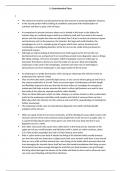
preview:• The endocrine function is producing hormones but exocrine is producing digestive enzymes. • In the second portion will be looking at conditions associated with malabsorption of nutrients and there's quite a few of these. • In comparison to previous lectures where we've looked at the heart or the kidney for instance they are confined organs which are relatively small and if you look at the overall picture not that complex but when we talk about the GI tract it consists of nu...
- Package deal
- Class notes
- • 9 pages's •
-
Aston University, Birmingham•clinical sciences
-
clinical sciences BM5CLS• Bysarah21jan
Preview 2 out of 9 pages
preview:• The endocrine function is producing hormones but exocrine is producing digestive enzymes. • In the second portion will be looking at conditions associated with malabsorption of nutrients and there's quite a few of these. • In comparison to previous lectures where we've looked at the heart or the kidney for instance they are confined organs which are relatively small and if you look at the overall picture not that complex but when we talk about the GI tract it consists of nu...
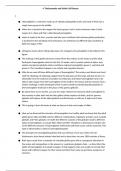
preview:● Haemoglobin is a tetramer made up of 4 globin polypeptide chains and each of them has a single haem group in the middle. ● When iron is bound to the oxygen the haem group is red in colour however when it lacks oxygen it is a blue and that's called deoxyhaemoglobin. ● Haem is made in the liver, muscles and also your red blood cells whereas globin production is localised to the red blood cell and humans can synthesise six different types of globin at different stages of life.
- Package deal
- Class notes
- • 12 pages's •
-
Aston University, Birmingham•clinical sciences
-
clinical sciences BM5CLS• Bysarah21jan
Preview 2 out of 12 pages
preview:● Haemoglobin is a tetramer made up of 4 globin polypeptide chains and each of them has a single haem group in the middle. ● When iron is bound to the oxygen the haem group is red in colour however when it lacks oxygen it is a blue and that's called deoxyhaemoglobin. ● Haem is made in the liver, muscles and also your red blood cells whereas globin production is localised to the red blood cell and humans can synthesise six different types of globin at different stages of life.
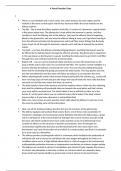
preview summary:• There's a renal medulla and a renal cortex, the cortex tends to be outer region and the medulla is the more central region and the key structure within the renal medulla are the kidney nephron. • Top left – this is what the kidney nephron looks like, it consists of a bowman's capsule which is this green region here. The glomerulus is kept within the bowman's capsule, and they combine to form the filtering unit of the kidneys. You have the afferent arterial supplying b...
- Package deal
- Class notes
- • 10 pages's •
-
Aston University, Birmingham•clinical sciences
-
clinical sciences BM5CLS• Bysarah21jan
Preview 2 out of 10 pages
preview summary:• There's a renal medulla and a renal cortex, the cortex tends to be outer region and the medulla is the more central region and the key structure within the renal medulla are the kidney nephron. • Top left – this is what the kidney nephron looks like, it consists of a bowman's capsule which is this green region here. The glomerulus is kept within the bowman's capsule, and they combine to form the filtering unit of the kidneys. You have the afferent arterial supplying b...
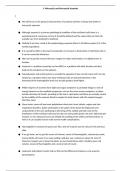
● We will focus on the general characteristics of anaemia and then I will go into detail on microcytic anaemia. ● Although anaemia is a primary pathological condition of the red blood cells there is a surprising lack of consensus on how it should be defined and the values that you find will actually vary from textbook to textbook. ● Globally if we have a look at the epidemiology anaemia affects 1.62 billion people (1/4 of the worlds population). ● It is caused by either a decrease i...
- Package deal
- Class notes
- • 10 pages's •
-
Aston University, Birmingham•clinical sciences
-
clinical sciences BM5CLS• Bysarah21jan
Preview 2 out of 10 pages
● We will focus on the general characteristics of anaemia and then I will go into detail on microcytic anaemia. ● Although anaemia is a primary pathological condition of the red blood cells there is a surprising lack of consensus on how it should be defined and the values that you find will actually vary from textbook to textbook. ● Globally if we have a look at the epidemiology anaemia affects 1.62 billion people (1/4 of the worlds population). ● It is caused by either a decrease i...
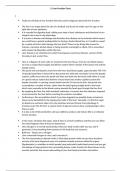
• The liver is an organ about the size of a football, and it just sits under your rib cage on the right side of your abdomen. • It is essential for digesting food, ridding your body of toxic substances and therefore has an integral role in day-to-day physiology. • It is prone to disease and damage and therefore liver disease can be inherited which means you could have a genetic predisposition to having a dysfunctional liver or it could be caused by a variety of factors that damage the li...
- Package deal
- Class notes
- • 8 pages's •
-
Aston University, Birmingham•clinical sciences
-
clinical sciences BM5CLS• Bysarah21jan
Preview 2 out of 8 pages
• The liver is an organ about the size of a football, and it just sits under your rib cage on the right side of your abdomen. • It is essential for digesting food, ridding your body of toxic substances and therefore has an integral role in day-to-day physiology. • It is prone to disease and damage and therefore liver disease can be inherited which means you could have a genetic predisposition to having a dysfunctional liver or it could be caused by a variety of factors that damage the li...
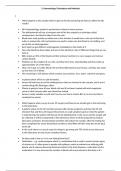
• All of haematology analysis is performed on blood or bone marrow. • The phlebotomist will use a torniquet and will do the sample by a technique called venepuncture, the blood is taken from the vein. • Blood clots really quickly so within two to five minutes it would form a clot and a fluid so in order to analyse the cells and proteins we need to make sure that blood is not clotting, and we do this via anticoagulants. • Each tube has got different anticoagulant embedded on the inside...
- Package deal
- Class notes
- • 11 pages's •
-
Aston University, Birmingham•clinical sciences
-
clinical sciences BM5CLS• Bysarah21jan
Preview 2 out of 11 pages
• All of haematology analysis is performed on blood or bone marrow. • The phlebotomist will use a torniquet and will do the sample by a technique called venepuncture, the blood is taken from the vein. • Blood clots really quickly so within two to five minutes it would form a clot and a fluid so in order to analyse the cells and proteins we need to make sure that blood is not clotting, and we do this via anticoagulants. • Each tube has got different anticoagulant embedded on the inside...
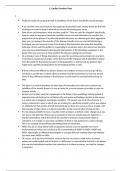
• If we consider how you'd want to best approach a potential exam answer these are the kind of things you want to keep in mind when you are structuring your essay. • Why do we use biomarkers, what are they used for? They are used for diagnosis specifically they are used to manage a particular condition so you can use biomarkers to monitor the progression of the disease if a particular protein increases as a disease gets more aggressive, then you can measure the severity of the disease. Eq...
- Package deal
- Class notes
- • 8 pages's •
-
Aston University, Birmingham•clinical sciences
-
clinical sciences BM5CLS• Bysarah21jan
Preview 2 out of 8 pages
• If we consider how you'd want to best approach a potential exam answer these are the kind of things you want to keep in mind when you are structuring your essay. • Why do we use biomarkers, what are they used for? They are used for diagnosis specifically they are used to manage a particular condition so you can use biomarkers to monitor the progression of the disease if a particular protein increases as a disease gets more aggressive, then you can measure the severity of the disease. Eq...
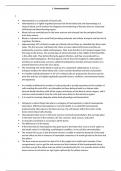
• Haemopoiesis is a production of blood cells. • Haemopoiesis is a tightly regulated process that forms blood cells and haematology is a study of blood, and it involves the diagnosis and monitoring of diseases that are associated with blood and blood forming organs. • Blood cells are manufactured in the bone marrow and released into the peripheral blood once they mature. • Blood is a dynamic and crucial fluid providing molecular and cellular transport and has lots of regulatory functi...
- Package deal
- Class notes
- • 8 pages's •
-
Aston University, Birmingham•clinical sciences
-
clinical sciences BM5CLS• Bysarah21jan
Preview 2 out of 8 pages
• Haemopoiesis is a production of blood cells. • Haemopoiesis is a tightly regulated process that forms blood cells and haematology is a study of blood, and it involves the diagnosis and monitoring of diseases that are associated with blood and blood forming organs. • Blood cells are manufactured in the bone marrow and released into the peripheral blood once they mature. • Blood is a dynamic and crucial fluid providing molecular and cellular transport and has lots of regulatory functi...
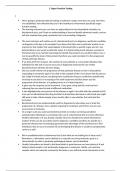
• We're going to predominantly be looking at reference ranges, how they are used, how they are established, how effective they are in the healthcare environment specifically organ function testing. • The learning outcomes are, you have an appreciation for how biomedical scientists use biochemical tests, you’ll have an understanding of how we identify abnormal results, and we will also evaluate how good a particular test is at providing a diagnosis.
- Package deal
- Class notes
- • 9 pages's •
-
Aston University, Birmingham•clinical sciences
-
clinical sciences BM5CLS• Bysarah21jan
Preview 2 out of 9 pages
• We're going to predominantly be looking at reference ranges, how they are used, how they are established, how effective they are in the healthcare environment specifically organ function testing. • The learning outcomes are, you have an appreciation for how biomedical scientists use biochemical tests, you’ll have an understanding of how we identify abnormal results, and we will also evaluate how good a particular test is at providing a diagnosis.
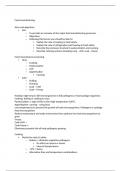
Aims and objectives. • Aim – To provide an overview of the major food manufacturing processes. – Objectives – Following this lecture you should be able to: • Explain the role of cooking in food safety. • Explain the role of refrigeration and freezing in food safety. • Describe the processes involved in pasteurisation and canning. • Describe catering systems including cook – chill, cook – freeze
- Package deal
- Class notes
- • 11 pages's •
-
Aston University, Birmingham•clinical and food microbiology BM6CFM
-
clinical and food microbiology lecture 1-16• Bysarah21jan
Preview 2 out of 11 pages
Aims and objectives. • Aim – To provide an overview of the major food manufacturing processes. – Objectives – Following this lecture you should be able to: • Explain the role of cooking in food safety. • Explain the role of refrigeration and freezing in food safety. • Describe the processes involved in pasteurisation and canning. • Describe catering systems including cook – chill, cook – freeze
